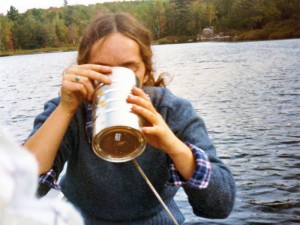
On my first camping trip we drank the water out of the lake with our bailing buckets. I remember lying in the tent listening to my stomach growl. We were lucky no one got Beaver Fever – Giardia.
Then we entered the days of lugging water jugs across portages. Water was like gold – it was rationed and guarded to ensure there wasn’t a drop spilled. The alternative was boiling lake water – a time consuming and fuel intensive process. We never used iodine tablets, but that was an option some people chose.
Finally we discovered water filters. These small light weight hand pumps were a life saver and allowed for longer canoe trips. The filter system made it possible to pump water right from the lake into a water bottle. Perfect!
Hand Pump
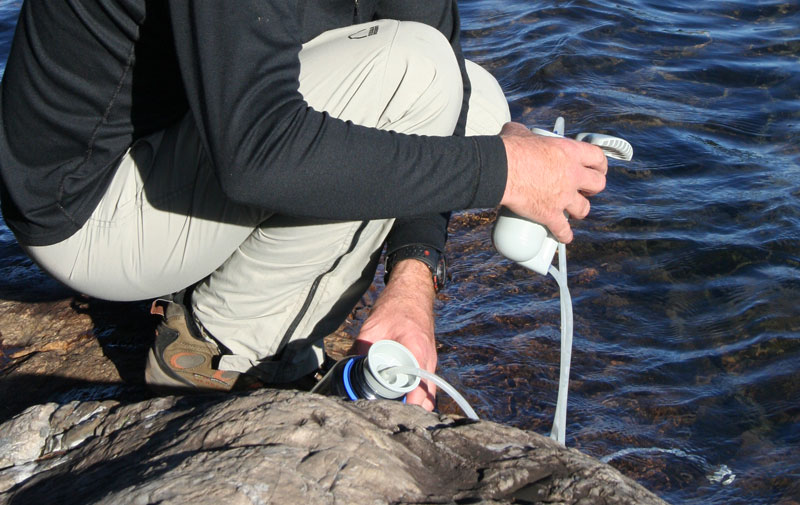
We have used our trusty PUR Hiker pump water filter for years. It works great. We never had any problems. When it was time for a new water pump we replaced it with the same model. Many of our friends used the PUR as well. We have camped with people using a Katadyn hand pump and only one person had problems. We carried our pump in a small bag so it was protected and easy to pack. The bag also made it easy to hang so the pump could drain.
How it Works
There is a hose that leads from the pump to the water. Near the end of the hose there is a small acorn shaped filter. Just above this filter there is a small piece of foam that floats on the surface of the water to keep the filter from getting too close to the bottom of the lake. Using the pump handle the water is drawn up and into the body of the filter where it passes through the filter cartridge. The water comes out of the hose at the top of the filter and into the water bottle.

We always knew if someone screamed while pumping water it was likely an encounter with a prehistoric snapping turtle, emerging mysteriously from the depths. We assume turtles are attracted by the bobbing acorn just below the surface. It is a very weird and startling experience.
We bought an adapter for our Nalgene bottles which made it even easier to get the water into the bottle without spilling. We recently added a large plastic Nalgene canteen to our gear. These bags are light and they fold up so they don’t take up much room in a pack. Having a bag of water that you pumped in the evening means a quick cup of coffee in the morning – very important for groggy campers.
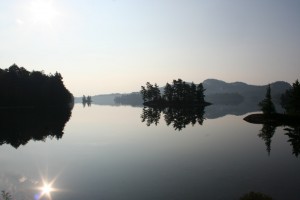
There is such solitude in the water pumping task. Sitting on the shore early in the morning or late in the day is magical. One of my all time best camping memories was on the shores of OSA lake early one morning. The surface of the water was still, there wasn’t a sound. The sun was starting to warm the air – it was going to be a perfect day. I saw two canoes coming up the lake heading toward the portage. It was a group of twenty somethings getting an early start to the day. They were all singing “American Pie”. It appeared that this group actually knew all the words. They would have made their baby boomer parents so proud.
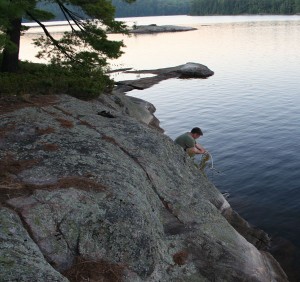
Gravity Filter
As time went on squatting at the shore to pump water became less appealing. For most of us it became a knee issue. Finding a nice flat rock, next to the water wasn’t always an option. Pumping water soon became a job that was put off hoping that someone else would jump in and do it. No one in our group ever fell in, but when you stand up after pumping, the head rush and numb feet make this a real possibility.
At some sites, reaching the shore isn’t easy. This means someone needs to paddle out in the canoe to pump water. While this can still be beautiful, it does take a bit more effort, especially on windy days. It is also the last thing you will want to do at night or early in the morning when other campers are already sitting by the water drinking coffee.
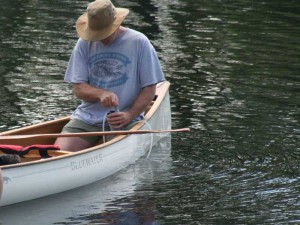
Thank goodness water filters continued to evolve. The people who design water filters must have known that baby boomers would still want to camp in the back-country.
How it Works
With these new filters all you need to do is scoop up some water into the water bag. If you keep the water bag handy in the canoe you can do this as you are arriving at your site. Once you reach shore you just hang the bag from a tree and let gravity do the work for you.
The water flows from this bag of lake water, through a filter cartridge and down a tube. There will be a tap on the hose for turning the water on and off. Ideally you can have the hose drain into a second bag that collects the potable water. This bag will have a spout you can use to release the water into your water bottle or a pot.
I must admit we were the hold outs in our group. I think we thought it was a bit too easy. We also get attached to our gear and we are a bit routine. But after spending two trips watching people turning a tap to get water, lots of water, we were sold. Well actually we were sold but we didn’t buy – we were given a new MSR AUTOFLOW Gravity Filter as a gift.
We love it! We will still take the PUR on short trips or on hiking trips but on longer canoe trips our new filter is the way to go!
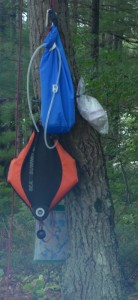
We also find that now that most of our meals are dehydrated, we use a lot more water for cooking. Gravity filters are just so convenient!
MSR AUTOFLOW Gravity Filter – The advantage with our model is the filter placement; it’s external to the actual water bag – it’s on the line. This is a big improvement from the earlier models. This means you can back flush the filter cartridge to clear it. Outdoor Gear Lab Review.
Katadyn – We camp with people who are happy with their Katadyn filter. These models have the filter inside the bag which isn’t as handy as the external filter.
With any water filter, there are a few steps when you get home. Keep the instructions for cleaning handy – if you take the time to follow the cleaning steps your filter cartridge will last a long time and you won’t have any unpleasant surprises when it’s time to pack for your next trip.

